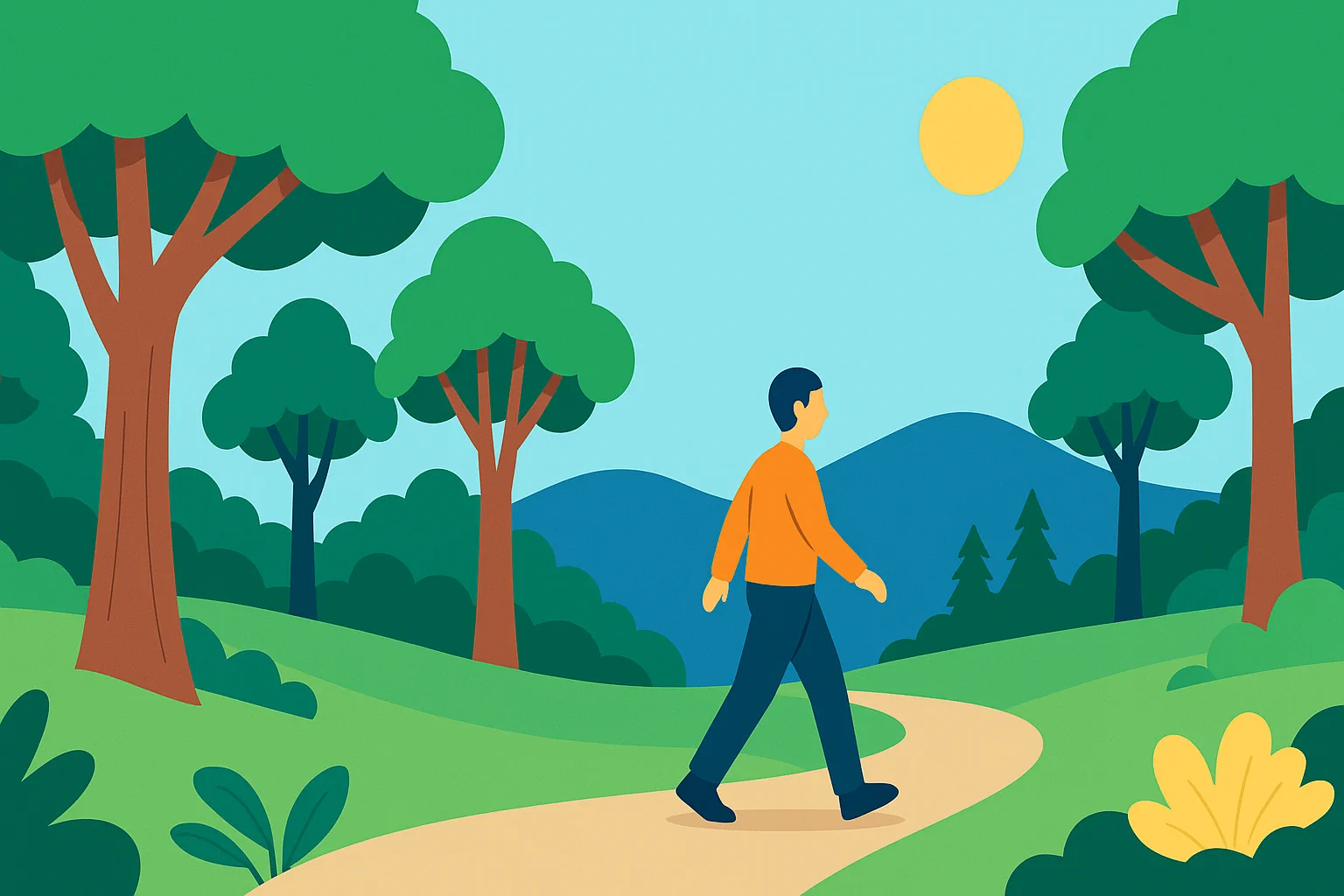It begins with something simple: a walk among trees. Sunlight filters through the canopy, birds chatter unseen, and the air is cool and rich with the scent of damp soil. At first you might notice your phone buzzing in your pocket, or the to-do list you left unfinished. But soon, the forest takes over. Your breath slows. Your mind quiets. The world feels softer.
This is forest bathing, also known as shinrin-yoku, a Japanese practice of immersing yourself in nature to restore balance and health. It is not hiking for fitness, nor is it a picnic or camping trip. It’s about presence. And increasingly, science is showing that this presence — stepping away from screens, noise, and stress into the embrace of nature — can change us in measurable, profound ways.
What Exactly Is Forest Bathing?
The term shinrin-yoku was coined in Japan in the 1980s, when the government recognized the toll of rapid urbanization and long work hours on public health. Officials encouraged citizens to spend time in forests not for exercise, but to “take in the forest atmosphere.” The practice soon gained cultural traction, and within decades, researchers began to test its effects.
Unlike structured fitness activities, forest bathing doesn’t require special skills or equipment. It’s less about miles walked than minutes noticed. A 20-minute stroll through a local park, taken with awareness and intention, can be enough. The key is slowing down and engaging all your senses: noticing the rustle of leaves, the roughness of bark, the play of light and shadow.
Why It Matters Today
In a world where most people spend more than 90% of their time indoors, contact with nature has become scarce. Screens dominate attention; cities crowd out green spaces. Stress, anxiety, and burnout are on the rise globally. Against this backdrop, forest bathing feels almost radical in its simplicity.
Unlike many wellness practices that require classes, equipment, or apps, forest bathing is free, accessible, and immediate. A small city park can offer the same physiological benefits as a mountain forest. More importantly, it offers something many of us are desperate for: a chance to step out of constant stimulation and reconnect with the natural rhythms that shaped our evolution.
The Science Behind Forest Bathing
Forest bathing is not just poetic. It is one of the most scientifically studied nature-based wellness practices, with evidence spanning physiology, psychology, and even immunology.
Stress and Hormones
Multiple studies show that time in nature lowers cortisol, the primary stress hormone. One landmark experiment in Environmental Health and Preventive Medicine found that people walking in forests had significantly lower cortisol levels, heart rates, and blood pressure compared to those walking in urban environments. Their nervous systems shifted toward the parasympathetic state — the body’s “rest and digest” mode.
Mental Health and Cognition
The psychological effects are equally powerful. Research in Frontiers in Psychology demonstrated that just 50 minutes in nature improved attention and working memory compared to time spent in a city setting. Other studies show reductions in anxiety and depression symptoms after guided forest therapy. Importantly, these benefits occur quickly, often within 15–20 minutes of exposure.
Immune Function
Perhaps the most fascinating discovery comes from Japan, where scientists studied the effects of forest air itself. Trees release natural compounds called phytoncides — antimicrobial essential oils that protect them from insects and pathogens. When humans inhale these compounds, our bodies respond. Research by Dr. Qing Li at Nippon Medical School showed that spending time in forests increased the activity of natural killer (NK) cells, key components of the immune system that fight infections and may help prevent cancer. Remarkably, the immune boost lasted for days after the forest visit.
Cardiovascular Health
Systematic reviews have found that exposure to green spaces correlates with lower risks of hypertension and heart disease. A large meta-analysis in Environmental Research concluded that people living near green spaces had significantly better health outcomes, from cardiovascular to metabolic markers.
Children and Cognitive Development
Even short-term exposure matters. A study in PNAS found that children attending schools with more surrounding greenery had better cognitive development over time. The implication is profound: contact with nature during formative years may shape brain function for life.
How Forest Bathing Works
Why does something as simple as walking in nature have such wide-ranging effects? Scientists propose several mechanisms:
- Sensory relief: Natural environments reduce sensory overload, giving the brain a chance to rest.
- Attention restoration: The “soft fascination” of nature — the way a flowing stream or shifting clouds hold attention gently — restores mental energy depleted by focused work.
- Physiological regulation: Visual exposure to greenery and natural sounds triggers relaxation responses in the nervous system.
- Biochemical interaction: Inhaled phytoncides may directly influence immune and hormonal systems.
Together, these mechanisms explain why forest bathing benefits both mind and body, often in ways traditional wellness practices cannot replicate.
Practicing Forest Bathing: A Gentle Guide
You don’t need to travel to remote wilderness to practice forest bathing. A local park, botanical garden, or even a tree-lined street can work. The practice is less about location and more about intention.
Begin by setting aside time. Put your phone on silent. Walk slowly. As you move, notice each sense in turn: the sound of birds, the feel of a breeze, the smell of pine needles or damp earth. Pause to observe small details — a leaf’s veins, the play of light through branches. If it feels natural, sit and breathe deeply, letting your body adjust to the slower rhythm of the environment.
Many practitioners keep a simple journal afterward, noting how their mood, energy, or thoughts shifted. Over time, these reflections build awareness of nature’s consistent impact.
Why It Resonates Now
Forest bathing is growing in popularity for good reason. In the aftermath of a global pandemic, mental health has become a priority. Digital fatigue is universal. People crave grounding practices that don’t add more noise or pressure. Forest bathing offers that antidote.
It also connects personal wellness with planetary wellness. By spending time in green spaces, people often develop a stronger commitment to environmental conservation. This “reciprocal healing” — nature heals us, and we protect nature — may be one of its most important long-term effects.
The Bigger Picture
Forest bathing is not a replacement for therapy, medication, or structured exercise. But it is a powerful complement. Like meditation, yoga, or journaling, it provides a low-cost, accessible way to reduce stress and nurture resilience. Its unique gift is that it requires no special skill — only a willingness to be present.
In an age of hyper-connectivity, forest bathing reminds us of a deeper connection — to the earth, to our bodies, and to the quiet spaces where healing begins.
References
- Park, B.J. et al. (2010). “The physiological effects of Shinrin-yoku: Evidence from field experiments in 24 forests across Japan.” Environmental Health and Preventive Medicine.
- Berman, M.G. et al. (2012). “Interacting with nature improves cognition and affect for individuals with depression.” Frontiers in Psychology.
- Li, Q. et al. (2008). “Forest bathing enhances human natural killer activity and expression of anti-cancer proteins.” International Journal of Immunopathology and Pharmacology.
- Twohig-Bennett, C. & Jones, A. (2018). “The health benefits of the great outdoors: A systematic review and meta-analysis of greenspace exposure and health outcomes.” Environmental Research.
- Bratman, G.N. et al. (2019). “Nature and mental health: An ecosystem service perspective.” Science Advances.
- Dadvand, P. et al. (2015). “Green spaces and cognitive development in primary schoolchildren.” PNAS.
- Hansen, M.M., Jones, R., & Tocchini, K. (2017). “Shinrin-yoku (forest bathing) and nature therapy: A state-of-the-art review.” International Journal of Environmental Research and Public Health.
- Harvard Health Publishing. “A prescription for better health: go alfresco.” Link

